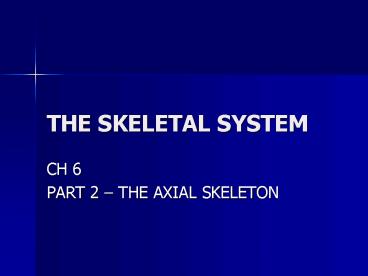THE SKELETAL SYSTEM - PowerPoint PPT Presentation
1 / 23
Title:
THE SKELETAL SYSTEM
Description:
THE SKELETAL SYSTEM CH 6 PART 2 THE AXIAL SKELETON AXIAL SKELETON SKULL HYOID BONE VERTEBRAE RIBS STERNUM SKULL 2 major segments: Cranium & Facial bones PURPOSE ... – PowerPoint PPT presentation
Number of Views:46
Avg rating:3.0/5.0
Title: THE SKELETAL SYSTEM
1
THE SKELETAL SYSTEM
- CH 6
- PART 2 THE AXIAL SKELETON
2
AXIAL SKELETON
- SKULL
- HYOID BONE
- VERTEBRAE
- RIBS
- STERNUM
3
SKULL
sutures
- 2 major segments
- Cranium Facial bones
- PURPOSE protects the brain and the sensory
organs - The ONLY mobile bone is the MANDIBLE (lower jaw)
- The location that the skull bones unite is at the
SUTURES or seams
4
SINUSES are located within the dense portion of
the skull and are air- filled cavities They
lessen bone weight, provide resonating chambers
for vocalization, moisten/warm air, and are a
site of mucous secretion
Sinuses are usually named for the skull bone
that contains the sinus
5
SKULL
- The nostrils open into 2 major air passages that
end in the throat. The nasal passages are filled
with very fine scrolls of bone called TURBINATES.
The turbinates are covered in pink tissue
(mucosa) similar to the lining of the mouth. Air
is warmed, moistened, and filtered as it passes
through the turbinates in the nose on the way to
the lungs.
turbinates
6
SKULL
- CRANIAL BONES
- FRONTAL BONES (6) form the forehead, the
orbits, and the front portion of the cranial
floor. - Horns are an extension of the frontal bone
- PARIETAL BONES (7) form the roof and upper
part of each side of the skull - OCCIPITAL BONE (8) forms the back of the skull
7
SKULL
- FORAMEN MAGNUM opening at the base of the
occipital bone that allows the spinal cord to
pass from the skull to the spine - TEMPORAL BONES (9) form part of the cranial
floor and the lower part of the sides. Contains
middle and inner ear structures
8
SKULL
- FACIAL BONES
- MAXILLA (3) bones that form the upper jaw,
nose, orbits, and roof of the mouth - MANDIBLE forms the lower jaw. Only movable bone
in the skull
maxilla
mandible
9
SKULL
- HYOID APPARATUS U shaped structure made up of
both bone and cartilage. Located above the
larynx, below the mandible, and is suspended from
the temporal bones via ligaments. Suspends the
tongue, larynx, and floor of the mouth
10
VERTEBRAL COLUMN
- BACKBONE
- PURPOSE protects the spinal cord, supports the
skull and thorax, stiffens the trunk, anchors the
pelvis, provides muscle attachment - There are 5 types of vertebrae cervical (C),
thoracic (T), lumbar (L), sacral (S), coccygeal
(Cy)
11
- Each vertebrae has a body and an arch.
- Body bears the weight
- Arch forms the canal that houses the spinal cord
- Intervertebral discs are between the bodies
- -Made of cartilage and serve as shock absorbers
- Processes extend out from dorsal and lateral
vertebral surfaces
12
(No Transcript)
13
- FORMULAS
- DOG/CAT C(7), T(13), L(7), S(3), Cy(6-23)
- HORSE C(7), T(18), L(7), S(5), Cy(15-21)
- COW C(7), T(13), L(6), S(5), Cy(18-21)
- PIG C(7), T(14-15), L(6-7), S(4), Cy(20-23)
- SHEEP C(7), T(13), L(6-7), S(4), Cy(16-18)
14
CERVICAL VERTEBRAE
- 1st vertebrae ATLAS supports the skull
- 2nd vertebrae AXIS
- what the atlas rotates on
15
THORACIC VERTEBRAE
- Attach to ribs
16
THORACIC CAGE
- Composed of the thoracic vertebrae, ribs, costal
cartilages, and sternum - Thoracic cage protects the vital organs of the
chest and allows the lungs to expand and contract
during respiration
17
RIBS
- RIBS
- PURPOSE form the thoracic wall and protect the
heart and lungs - Flat, curved
- Each rib has bony and cartilagenous components
- The cartilagenous component is located ventrally
- They unite at the costochondral junction
18
RIBS
- All attach to the thoracic vertebrae dorsally
(the number of thoracic vertebrae the number of
ribs) - Differ in the attachment to the sternum
- 1st 7-9 join directly with the sternum TRUE
RIBS - The caudal ribs unite with the cartilagenous
portion of the true ribs. They are called FALSE
RIBS - The most caudal ribs due not unite with anything
ventrally and appear to be floating, so they
are called FLOATING RIBS
19
RIBS
20
STERNUM
- BREASTBONE
- Located on ventral midline of chest
- Flat bones called STERNEBRAE that connect to each
other via cartilage - Most cranial aspect is the manubrium
- Most caudal aspect is the xiphoid process
21
LUMBAR VERTEBRAE
- Support the abdomen
22
SACRAL VERTEBRAE
- One bone that results from the fusion of 3-5
vertebrae - Attaches to pelvis
23
COCCYGEAL VERTEBRAE
- Also called caudal or tail vertebrae
- Can be docked- spinal cord ends near the
lumbosacral junction































